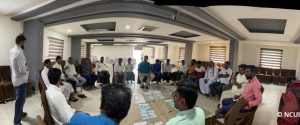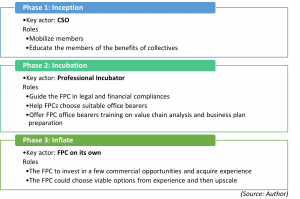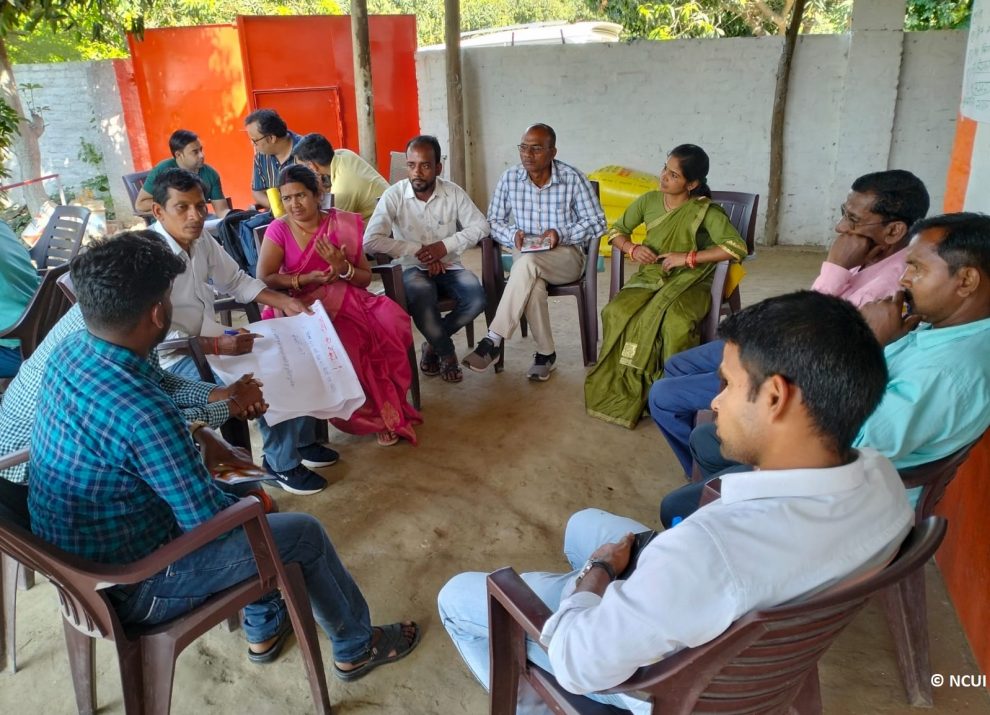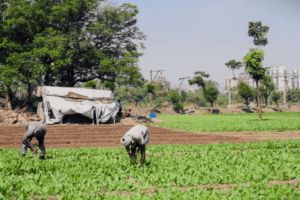Farmers, more so the men, have a poor history of working together as a collective. Today, Farmer Producer Companies (FPCs) are mooted as a silver bullet to catapult farmers into entrepreneurs. Many not-for-profit organizations are willingly, or often unwittingly, promoting FPCs that are supposed to be profit making. Apparently, there are many stumbling blocks. Dr Arun Balamatti examines only the process part of the FPCs’ evolution and discusses the roles of various players, the required skill sets, challenges, issues, and then invites the attention of the government and key stakeholders to revisit the template.
“There seem to be but three ways for a nation to acquire wealth. The first is by war…This is robbery. The second is by commerce, which is generally cheating. The third is by agriculture, the only honest way, wherein man receives a real increase of the seed thrown into the ground, in a kind of continual miracle, wrought by the hand of God in his favour, as a reward for his innocent life and his virtuous industry”.
― Benjamin Franklin
INTRODUCTION
We have moved on from the Self-Help Groups (SHGs) and entered another phase of working with groups of rural communities, and currently with Farmer Producer Companies (FPCs). Of course, there were attempts to harness the potential of SHGs in agricultural development, which were met with mixed results, primarily because almost all the SHGs were composed of only women. There has always been need for an institutional mechanism since it does not make economic sense for the small and marginal farmers (over 85%) to operate as individuals. We are now given to believe that FPCs are the way forward and they will be able to deal with every challenge in agriculture. These lofty expectations could well weigh down the FPCs as farmers have not worked as collectives in the past.
It appears that all the stakeholders are convinced that FPCs are the ultimate panacea for all the farmers’ plight, except the farmers themselves. There is a government policy to promote and support FPCs; there are agencies scrambling to promote FPCs; there are centers of excellence for FPCs; there are resources being made available by different agencies; there are corporates willing to invest in aggregation; there are value chain funders to reduce cash flow crunches for the FPCs. However, except for the logic that most of the small and marginal farmers cannot access knowledge, harness technology, or benefit from the input and output markets so long as they operate as individuals, nothing else seems to make logical sense on the larger FPC canvas – if the farmers have difficulty coming together as a cohesive group.
| Box 1: Evolution of FPCs In 2003 the YK Alagh Committee recommended the formation of FPCs, a combination of the cooperative form and the company form. Today, there are 33,711 FPCs registered across India, that brought in over 28.20 lakh farmers into their fold in 28 states and seven Union Territories. But let us not get swayed simply by the sheer numbers, let us see what some of these numbers actually mean. It was only in 2012, a decade after the enactment, that the FPCs started showing up; between 2014 and 2018 as many as 5,058 FPCs were registered. The real surge occurred between 2020 and 2022 during which period 25,750 FPCs were registered (over 76% of the total). Going by the total number of FPCs and shareholders, it works out to less than 84 members per FPC, too few to constitute a decent paid-up capital. Among the 28 states and seven Union Territories, only six states contribute the majority of FPCs, i.e., 21,285 (63%), and 18.36 lakh shareholders (65%) – Bihar, Maharashtra, Odisha, Rajasthan, Tamil Nadu, and Uttar Pradesh. These six have more than 500 FPCs per state; Maharashtra alone contributing over 34% of the FPCs (11,540). Given that the National Bank for Agriculture and Rural Development (NABARD) and the Small Farmers’ Agri-Business Consortium (SFAC) are the major players in promoting FPCs in the country, the available shareholder details of FPCs under each of these are only 21% and 14%, respectively, whereas the details of 43% of shareholders are not available. The available data on revenue across 2,727 FPCs is INR 3989.9 crores, an average of INR 1.46 crore; it is quite likely that the major portion of the revenue may be sitting in the accounts of only a handful of FPCs (https://fpo.tci.cornell.edu/dashboard). What the numbers mean is, the story of FPCs has only just begun, their growth and distribution in the number of FPCs, membership, and revenue is lopsided. The few extraordinary success stories may be coming from the five thousand plus FPCs started between 2014 and 2018 while the 25,000 plus FPCs that have come up only after 2020 could still be struggling with many challenges. |
Here are the arguments as to why the template we have put in place for the FPCs is defying our efforts to achieve the larger goal – a better deal for all farmers.
WHY FPCs?
The best thing for an Extension worker to realize in their career, early on, is that there is a limit to their ability in increasing crop productivity and optimizing production costs. This leaves us with a hard-hitting truth about how little a farmer earns after all the hardship they put up with. Their lives are a constant struggle against increasing cost of inputs, farm gate prices that refuse to budge for years, and the interplay of so many variables – erratic rainfall, ever-undependable laborers, invasive pests, unknown diseases. Too many odds are stacked against farmers keeping them from celebrating the occasional triumph. What a farmer earns at the end of one good harvest is always inadequate if one understands the fact that the profits from one good crop must cover the losses of a few previous crops and the almost inevitable uncertainty of the next crop.
When a tomato farmer sells his produce at Rs. 10 a kilo and goes to the market the next day and must buy the very same thing for himself at Rs. 40 a kilo, he apparently finds it grossly unfair. The management gurus explain to him why it is not at all iniquitous; between wholesaling and retailing there are things such as grading, transportation, perishability, risk around investments, and a scale at which all this works. This is how the idea of aggregation is being sold, which is often not fully understood by the farmer, because farmers, in general, have always operated as individuals, have focused on production, have been glad, or have often been compelled, to dispose of their produce immediately after harvest. The idea that a greater share of the consumer rupee can be harnessed by farmers only by taking a few steps beyond production is not merely a matter of comprehension on the part of farmers but that these next steps, post-production, are not the ones to be taken individually but collectively. The farmers have not done it in the past; they, on their own, are not able to do it even now. Farmers graduating to become farmer-entrepreneurs must therefore be a guided process. This is where the government comes in with an enabling policy on FPC. A policy, however, is only a trigger, and it must open up opportunities for those who can make it happen.
WHAT IS AN FPC?
An FPC is a legal entity of any kind of producer – agricultural produce, forest produce, artisanal products, or any other local produce – where the members and managers are the primary producers. An FPC, therefore, is an institution of the farmers, by the farmers, and for the farmers. Going forward, the FPC is meant to take care of the flaws in cooperative societies (such as external interference), keeping its strengths (collectivization of people and their interests) and borrowing the strengths of the corporates (financial discipline).
|
Box 2: Cooperative vs. FPC An FPC, unlike a cooperative, is an exclusively farmer-centric profit-seeking entity. However, farmers as we know them, are recognized more for their hard work, magnanimity, and ignorance, especially on the market front. Farmers have always considered farming as a full-time occupation; they have rarely ventured into any activity beyond production. The prerequisites of success in the market are QUALITY of the product, EFFICIENCY with which it is produced, SCALE, and CAPITAL. If we agree these are all the basic ingredients necessary for an entrepreneur to succeed, farmers as a community have not really demonstrated that they have the required entrepreneurship spark in their DNA. To put it briefly, the market demands different skills and attitudes. |
The quote at the head of this article by Benjamin Franklin says, ‘Commerce is generally cheating’. We have never associated this trait with farmers who are engaged in farming, a ‘virtuous industry’. What is certain is that farmers must function as collectives for this, and they need to learn a few new skills. However, the farmers are not forming the FPCs by themselves, and the not-for-profit organizations – the agencies not conversant with entrepreneurial skills – are promoting most of the FPCs.
Key Skills for FPC Success
Promoting successful FPCs demand multiple skill sets; the three critical skills mentioned below illustrate why it is not everyone’s cup of tea.
- Social engineering: If we were to follow the template that helped the SHGs succeed, the promotion of successful FPCs requires the promoting agency to begin by developing rapport with the community, initiating the formation of small and cohesive groups, introducing savings and thrift habits, educating members and office bearers on democratic functioning, financial management skills, and then bringing together disciplined and willing smaller groups on to a larger platform that can work as an FPC. This is a slow and complex process that can be managed by only those agencies that have had experience working with SHGs or SHG-like institutions. There are civil society organizations (CSOs) that are best suited to do this job. But, make no mistake, making an individual farmer understand the value of joining a group is only the beginning of an FPC, not the end.
- Technology management: The production part in terms of crop choice, acquiring critical technologies (inputs), and knowledge of the actual production process is another skill which many farmers are familiar with, on an individual basis. However, the choice of crop or enterprises (such as dairy, poultry, and managing small ruminants) for individuals and for a collective could be entirely different depending on the resources (capital and more importantly, intellectual), and the possible scale of operation depending on the number of members in each FPC. Many CSOs engaged in promoting FPCs may struggle in recognizing the strengths, weaknesses, opportunities, and threats when it comes to facilitating the operations from farm to fork, and suitably guiding the FPCs in managing these operations as a collective.
- Enterprise management: The next step, after ensuring an FPC is formed with like-minded individuals who have gone through a minimum apprenticeship on working as a collective with proper fiscal management and book-keeping, is to progress to enterprise management. This requires FPCs to deal with the challenges in both the input market and the output market that have a direct bearing on the production costs and profitability. And to be able to succeed in the input and output markets the FPCs and or the promoting agencies need the wizardry to identify and pick only those enterprise ideas, which are commercially viable, understand the value chain, develop business plans, and mobilize capital for short and longer-term investments. Unfortunately, the competence and experience in managing this part of building an FPC are certainly not the strengths of farmers nor of many CSOs.
In simple terms, social engineering is what the CSOs are good at, and technology management is something most farmers are capable of handling, but enterprise management is where both struggle. Expecting the CSOs or any other single agency lacking in one or more of the three skills could be a risky affair.
CHALLENGES FACED BY FPCs
Not surprisingly, most of the FPCs are encountering many challenges, implying that neither the CSOs nor the members of the FPCs have the wherewithal to deal with them. Here are some of the common problems faced by the FPCs.
- Difficulty in member enrollment: This is a typical problem of such CSOs that have not had experience in community mobilization, more specifically those which have no working experience with SHGs. If an FPC-promoting agency is struggling to ensure enough enrollment it could be because of one or many reasons, for example, they may have failed to instill confidence among farmers about the power of FPCs, its value, trust in the person chosen to lead the FPC, or the individuals chosen as directors on the governing board, or even the very familiarity or credibility of the agency which is promoting the FPC. Raising capital without proper onboarding of the shareholders could turn out to be a hurdle while making important decisions by the FPC.
- Capital mobilization: All the FPCs invariably claim they have inadequate paid-up capital, their transaction costs are extremely high, and hence many of their ‘plans’ cannot be executed. The maximum paid-up capital an FPC of a thousand members can raise through a share with face value of Rs 1000 is Rs. 10 lakhs. There are at least two issues if they are not able to mobilize enough shareholders. One, the FPCs are compromising on their social engineering process and hence they are not able to win the confidence of a thousand members or motivate a small number of members willing to buy a share with a higher price. This has multiple implications – the FPCs end up with less than the desired number of shareholders, and more seriously, those who buy the shares are less likely to know what the FPC is all about and what they can expect, leading to a gradual loss of trust in the FPC. The second issue is, assuming the FPC can mobilize only half the expected number of members, the FPC could choose to invest all or most of this capital into one or a few enterprises. This can be risky because when the capital investment gets larger the cash flow and returns take longer to materialize. If we were to draw a parallel from the case of listed companies, how many companies go to town pleading with people to buy their shares? Isn’t it the product or service, the value proposition, or the people who run the business that attract the shareholders? So, it is not about motivating the farmers to join the FPC but luring them toward a cause that assures them of some form of benefit.
- Limited sources: NABARD and SFAC are the leading agencies that came forward to promote and support FPCs by providing financial assistance in the form of time-bound working capital and matching grants. More importantly, these institutions are encouraging CSOs (mostly) to promote FPCs and the financial assistance to FPCs is being channelized through the CSOs. It seems that the CSOs are entirely dependent on the support of NABARD and SFAC for their FPC promotion activities, including staffing, whereas the money that the FPCs get is always seen as too little for investing in enterprises. Both the CSOs and the FPCs miss the point that their primary objective is to invest the paid-up capital in an enterprise, even if it is a small one, to begin with, earn profits, gain experience, and then think and act big. Excessively depending on the funds provided by NABARD, SFAC, and others is neither expected nor a desired way forward.
- Banks not prepared to lend: Another reason for not being able to invest and earn, often mentioned by many FPCs, is that they have little or no assets to mortgage and raise money. Their individual or common property such as farmland or a building does not qualify for collateral. This is, in fact, a blessing in disguise that they are not able to borrow before they acquire experience in handling commercial opportunities. They should rather start small, with paid-up capital, instead of going all out with borrowed money, risking their assets early in their entrepreneurial journey.
The challenges reveal the fact that the FPCs have difficulty mobilizing both human and financial capital, thus raising concerns about the success of the enterprise at an early stage.
Let us explore the issues that lead to these challenges and prevent many FPCs from getting off the starting block.
ISSUES WITH FPCs
- Collectivization and aggregation: There are fundamental flaws in the very understanding and operationalization of the principles of collectivization and aggregation. The small and marginal holdings have rendered farming uneconomical because the farmers buy inputs in retail, obviously in small quantities, and sell their little produce at a wholesale price, thus getting a poor deal at both ends. This is precisely the reason farmers should operate as collectives so that their input needs are pooled, and their produce can also be aggregated to harness the economies of scale. In practice, unless the farmers grow similar crops and varieties, aggregation of both the inputs and outputs is untenable. Therefore, it is not only important for the farmers from contiguous geography to come together to aggregate their input needs and output, but they should also work towards pooling their land resources to grow one or few crops on a large scale so that their input needs and outputs are similar, and hence can be easily pooled. While NABARD guidelines for FPCs clearly mention this we do not actually see any FPC practicing land pooling.
- FPC promoting agencies: Even though the FPCs are supposed to be by the farmers, of the farmers, and for the farmers, they are being promoted not by farmers but by others The irony is that it is mostly the ‘not-for-profit’ non-governmental organizations promoting FPCs that are supposed to be ‘making profit’. But unfortunately, there are no alternatives. None of the public or private Extension agencies have the skills and experience to provide professional handholding support through the FPC lifecycle. The only choice now is to work through a few select CSOs or other agencies that have acquired experience in the past few years and have demonstrated the ability to fill the missing gaps by networking, such as seeking guidance from Krishi Vigyan Kendra’s (KVK) for technical assistance and hiring professionals for value chain studies and business plan development.
- The FPCs lack a core focus: In the initial stages, there was an idea of promoting commodity groups, i.e., by collectivizing farmers producing certain crops. Eventually, the FPCs went on to first mobilize the farmers and then look for whatever entrepreneurial activities they wished to pursue. Although crop-specific FPCs are not really a clever idea, especially when the shareholders are growing more than one crop (which is what many farmers do), starting an FPC without clarity on a specific enterprise idea also does not help. The next point explains why.

- The cooperative hangover: It is evident that the majority of FPCs are getting into the trap of trying to meet every need of their members. Dealing with seeds, fertilizers, and agrochemicals as well as trying to procure and sell every product of its shareholders is an invitation to trouble. This move entails the risk of missing viable commercial opportunities. For instance, many FPCs invest their hard-earned paid-up capital in procuring chemical fertilizers in bulk by paying in advance, investing in their stocking, and ending up locking the capital because the sale in small quantities to member farmers over a longer period means the cash flow is in trickles. Similarly, another pet project of the FPCs is investing in a ‘Custom Hiring Centre (CHC)’, a high-investment enterprise that is full of risks. Buying expensive farm machinery and equipment and leaving them at the mercy of low-paid drivers or operators or even the member farmers renting them often leads to poor handling, heavy wear and tear, breakdown, and excessive maintenance costs. Neither fertilizers nor CHCs are high-margin enterprises.
There are two reasons for this cooperative hangover among the CSOs. One, many FPCs are being registered under the Cooperative Societies Act of the respective state or the Society Registration Act, 1860, or as Public Trusts under the Indian Trusts Act, 1882, simply because it is a lot easier than registering them as a Producer Company under Section 581(C) of Indian Companies Act, 1956, or Section 25 of the Indian Companies Act, 1956. Apparently, the objectives of the FPCs are written and followed typically to suit a cooperative society. The other reason is that the CSOs promoting FPCs are conversant with welfare activities rather than enterprise activities. The Alagh Committee (2002) had clearly mentioned in its report that registration as societies or public trusts is inherently unsuitable for commercial enterprises. The Committee said, ‘Companies Act offers a statutory and regulatory framework that allows for competition on an equal footing with other forms of enterprise. If the Companies Act is suitably adapted to serve producer-owned enterprises, their registration as a company will go a long way to advancing the interests of producers’.
- Who runs the FPCs: The requirement at the stage of registering an FPC is to have a minimum number of farmers as members, and a Board of Directors chosen from among them, including a designated president for the board. While NABARD stipulates 700 to 1000 members, an FPC can be registered even with just 10 farmers. The common mistake done at this stage is choosing the wrong people as directors and president or selecting them without the concurrence of all the shareholders. In the process, many FPCs end up choosing office bearers who harbor political aspirations or are looking for social esteem rather than the ones who have the inclination and ability to run the FPCs for the benefit of their members. The weakest link in the FPC structure, however, is in the choice of the Chief Executive Officer (CEO).
Many FPCs find it difficult to find a qualified and competent CEO among their members and hence hire an external person. And because the external person hired as a CEO needs to be paid a salary the FPCs look to NABARD and SFAC for resources. Since these agencies have a meager allocation for this role the FPCs end up hiring a less qualified person (normally a fresh agriculture graduate) with no prior experience in managing an enterprise. Such a person ends up being managed by the president (often equally inexperienced) or by a few dominant directors. The legal and financial compliances are often too intimidating for such a novice and running the business of an FPC is indeed a daunting task.
- Mismatch between volumes and earnings: A study of seven FPCs in Mysuru district during 2017 revealed that all the FPCs tended to show large volumes of transactions whereas their profits were negligible. Interestingly, we get to hear success stories or otherwise of many FPCs, but they hardly throw any light on their financial health. We are yet to see reports and feedback on the liquidity, solvency, profitability, and operating efficiency of the FPCs, the true measures of the success of enterprises.
THE NEED TO CHANGE THE TEMPLATE
Clearly, the farmers on their own are unable to form and run FPCs. The CSOs can be good at social engineering but will fall short in their ability to support the FPCs in technology and enterprise management. Unless this is understood and addressed, we are likely to see many FPCs being registered, only adding to the numbers but very few FPCs really achieving what they were meant to. Leaving the promotion and management of FPCs to private entities also has the risk of poor social engineering.
A possible strategy therefore could be to go with select CSOs that have acquired experience in the three phases of the FPC lifecycle described below, or to depend on multiple agencies sharing roles based on their core competencies.
The following graphic shows distinct phases of the FPC’s lifecycle, and who could play what role at each phase.
The FPC growth phases and the roles of key actors

The CSOs may lead the inception process with the social engineering part until the mobilization of the shareholders (Phase 1). A professional private entity or an incubator may step in at Phase 2 to help the FPC choose the governing board, president, and CEO, build their capacities on their respective roles, value chain analysis, preparation of business plans, and assist in the legal and financial compliances. Phase 3 should be for the FPCs to be enabled to run the affairs all by themselves with advisory support from private entities or incubators. While the CSO could anchor the FPCs throughout the lifecycle they should be aware of their critical and direct role during Phase 1, and the facilitation roles during Phases 2 and 3.
CONCLUSION
Typically, a company takes six to eight years to break even and stabilize with a decent profit. Many of the over 5000 FPCs registered between 2014 and 2018 should have reached this stage, but that has not happened, except for a few. Naturally so because FPCs are not typical companies in the sense the farmers lack entrepreneurial skills; furthermore, they are being coaxed into forming FPCs by agencies that are also constrained by their limited skills and abilities. Therefore, it is time to moderate our expectations, tactfully manage the process of promoting and enabling FPCs, and look for suitable agencies to meet the necessary competencies.
The CSOs need to quickly acquire new skills, the public Extension system itself needs to realize how farming is now being driven entirely by the markets, and therefore, adapt to market-led Extension.
The ever-increasing costs of agricultural inputs and the farmers’ continued struggle to get a fair deal for their produce emphasize the fact that the success of the FPCs is inevitable. The government has indeed recognized this fact and has been encouraging the promotion of FPCs on a war footing. But the obsession with numbers and ambitious targets needs to be moderated. Clarity on who comes in at what phase of the FPC’s lifecycle could certainly help improve the success rate of FPCs.
 Dr Arun Balamatti is a development professional, and he can be reached at arunbalamatti@gmail.com
Dr Arun Balamatti is a development professional, and he can be reached at arunbalamatti@gmail.com





This blog is not only rich in content but also very timely when so much is being talked about FPCs to the extent that many believe them as panacea for all that is not well in the farming sector. Appreciably, all possible bottlenecks in the success of FPCs have not only been very logically & convincingly covered but also suggestions are given to make them successful. The formation and success of FPCs is a matter of mindset too. For example, pooling up resources especially land is a very difficult task but it is almost a must thing to do if we want to see small scale farmers reaping benefits from farming through FPCs. I congratulate the author Dr Arun and AESA for bringing out a thought provoking, eyeopener masterpiece. It’s the 200th blog published by AESA, which is quite an achievement, a long road traveled ever since I wrote the very first blog for AESA in 2013. Anyone aspiring to be enlightened on FPCs would find it Worthwhile to read it… Happy reading!
Very lucidly written blog. Hope the people at the helm of affairs of both NABARD and SFAC take a cue from it. It serves as a piece of first-hand information to all the CEOs and other office bearers of the FPCs/FPOs. It will be more useful if the same shall be utilized by the respective FPCs in their local language and learn from it.
A worth reading blog !!
Dr Arun . I think you have been very conservative in your comments. FPOs can only be successful it is driven for profits by some smart individuals.
Though the FPCs are viewed as the new generation cooperatives and are aggressively promoted by Governments across the country, a reality check is necessary to understand their present status and constraints. As argued rightly in this blog, obsession with numbers and ambitious targets needs should not be the yardstick but the key performance indicators. This interesting blog not only covers various issues faced by the FPCs comprehensively but also reckons important suggestions. Thanks to AESA for publishing this informative blog. Also, I would like to convey my sincere thanks and congratulations to TEAM AESA for their efforts in bringing out 200 blogs on the various areas of Agricultural Extension